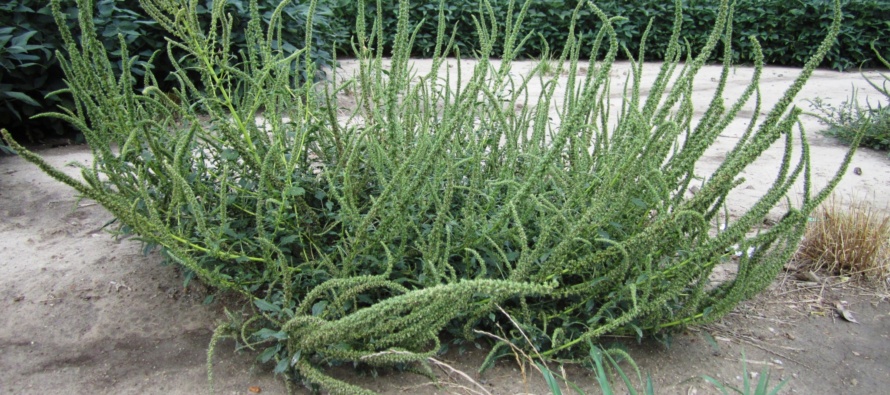Managing Palmer Amaranth on Field Borders

Related Articles
- 2010 Soybean And Corn Variety Trial Data 3
- Rice Variety Trial Results For 2010, Plus Rice Research Report 0
- Evaluation of Peanut Varieties in Mississippi, 2010 0
Latest Tweets
 One area of concern in glyphosate-resistant (GR) Palmer amaranth management is controlling this species on turnrows, field borders, and ditchbanks. Clean crop fields surrounded on turnrows and/or ditchbanks by GR Palmer amaranth is common, and this weed has also colonized fallow areas, road sides, and construction sites. When GR Palmer amaranth in these areas is not controlled, it produces seed which is disseminated into adjacent fields. Managing the soil weed seedbank is critical in the fight against GR Palmer amaranth.
One area of concern in glyphosate-resistant (GR) Palmer amaranth management is controlling this species on turnrows, field borders, and ditchbanks. Clean crop fields surrounded on turnrows and/or ditchbanks by GR Palmer amaranth is common, and this weed has also colonized fallow areas, road sides, and construction sites. When GR Palmer amaranth in these areas is not controlled, it produces seed which is disseminated into adjacent fields. Managing the soil weed seedbank is critical in the fight against GR Palmer amaranth.
Some options are available to manage GR Palmer amaranth along turnrows and ditchbanks. Unfortunately, none of these are foolproof. Mowing and tillage are options. While these tactics are somewhat effective, they must be performed repeatedly because control is rarely 100% and those remaining Palmer amaranth plants will produce seed which can reinfest crop fields. Tillage, usually in the form of disking, is more effective than mowing. However, disking will require multiple passes, is only effective on turnrows, and a disk is difficult to maneuver around pointed rows and power poles. A rotary mower is much easier to handle than a disk, but it will not kill GR Palmer amaranth, so the turnrow and/or ditchbank must be mowed repeatedly to avoid seed production.
Many growers prefer to chemically control GR Palmer amaranth on turnrows and ditchbanks, but the legality of these herbicide applications is often unclear. Most herbicide labels restrict application to water, but they do not always specify whether application to a ditch with no water is allowed. Some labels, such as dicamba (Clarity) and triclopyr (Garlon, Remedy), specifically address applications to “non-crop” areas. However, “non-crop” area is not clearly defined on most labels.
The true definition of a turnrow is vague as it relates to herbicide applications, and ditches fall into a number of categories, i.e., drainage, irrigation, non-flowing. However, some points are clear about herbicide applications to turnrows and ditchbanks. Gramoxone SL is not labeled for application to ditches. Glufosinate, when applied as Liberty 280 SL, is not labeled for application outside of crop fields. However, glufosinate as Rely 280 or Cheetah may be applied to “farmsteads”, which the herbicide labels define as “farmstead building foundations, shelter belts, along fences…ditch banks, dry ditches…and general nonselective farmstead weed control.” Although dicamba and triclopyr are labeled for some turnrow and/or ditchbank applications, most crop species are sensitive to these herbicides.
Diquat (1 to 2 quarts per acre), which is a group 22 herbicide similar to Gramoxone SL, is labeled for application to non-crop areas as well as non-flooded ditches. Direx may be applied to uncultivated agriculture areas at a rate of 4 to 12 quarts per acre. The combination of Diquat and Direx should control small, emerged GR Palmer amaranth and provide residual control if the application receives rainfall for incorporation.
Controlling GR Palmer amaranth on turnrows and ditchbanks has become a critical component to weed control. Unfortunately, not all the concepts related to the herbicide applications in these areas are clearly defined, so caution should be exercised before the herbicides are applied to turnrows and/or ditchbanks. When deciding to spray a turnrow, the herbicide label and manufacturer should be consulted to determine if the application is legal. Local drainage districts or state plant boards should be contacted before utilizing a herbicide to control GR Palmer amaranth on ditchbanks.





Good thoughts and definitely things to consider. Letting edges grow up really adds to the seedbank!
I’ve noticed where growers maintain a healthy stand of bermudagrass on their field borders and ditches they have substantially less pigweed. Maintaining turf on field borders could also be a cultural means of weed control to help protect some of these chemistries we will need long term. Not to mention reducing soil and nutrient loss.